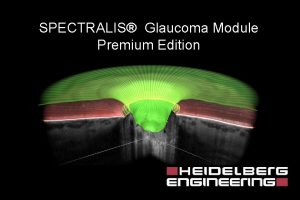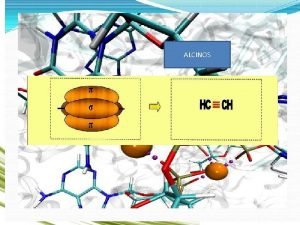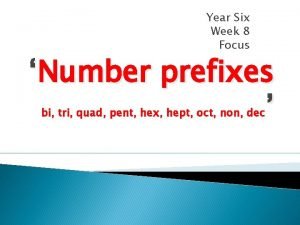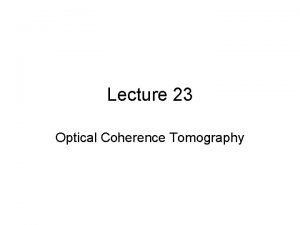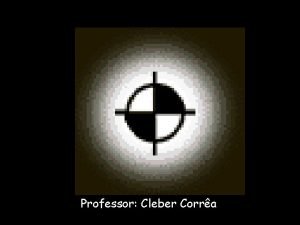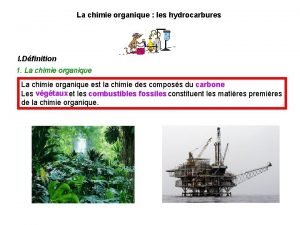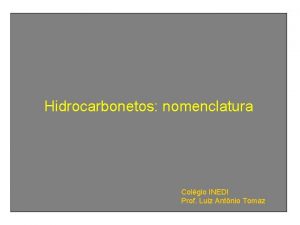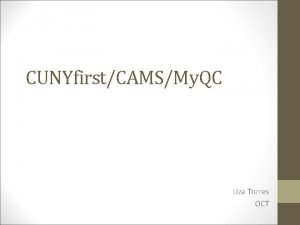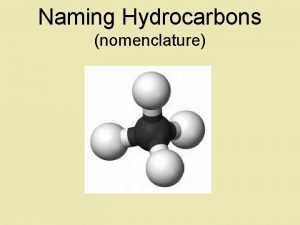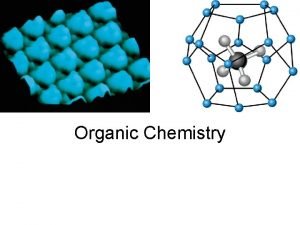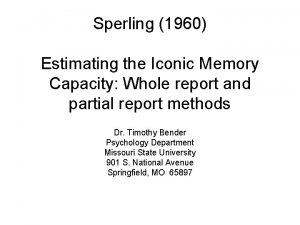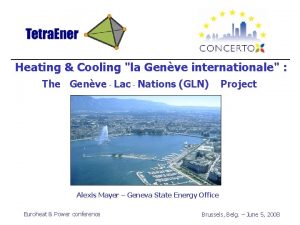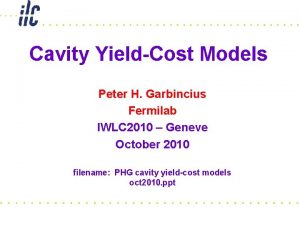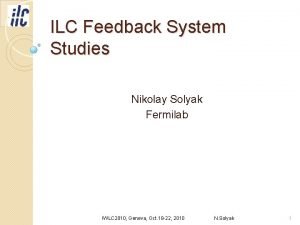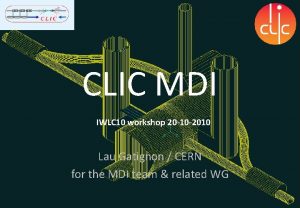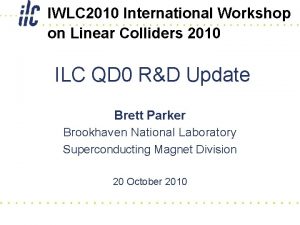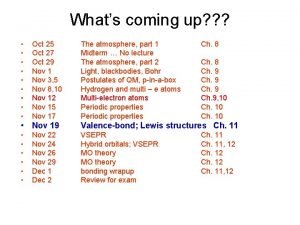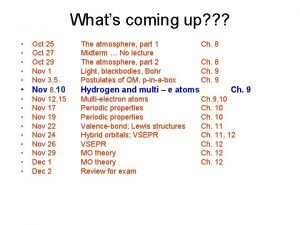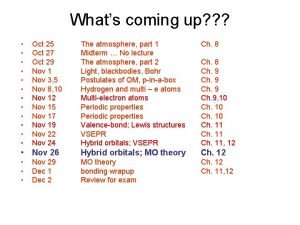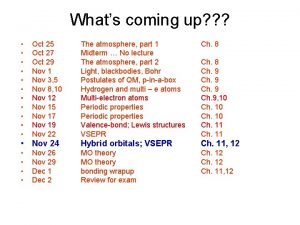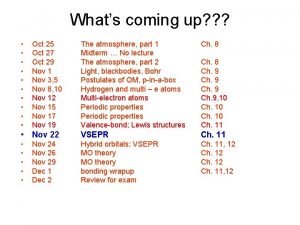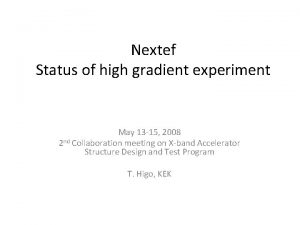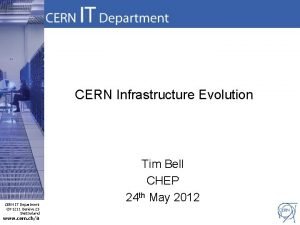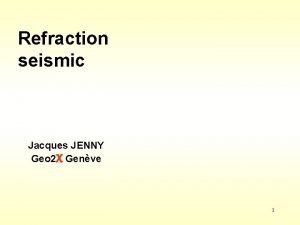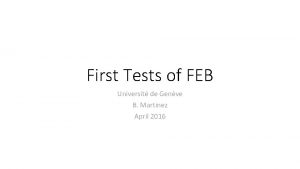Report from Nextef IWLC 10 Genve Oct 20



































- Slides: 35

Report from Nextef IWLC 10, Genève, Oct. 20 T. Higo (KEK)

Contents • • • 2010/10/20 Nextef TD 18 results and related issues Near future experimental plans Nextef expansion status Other associated activities Report from Nextef 2

Nextef has been keeping the same configuration since 2007 Nextef 2 klystron setup 2010/10/20 KT 1 1 klystron setup Report from Nextef 3

Studies at Nextef & KT 1 2008 7 Nextef 10 1 2009 4 7 10 1 2010 4 7 10 1 2011 4 7 10 1 2012 4 7 10 Pulse compression? Compete against structure test? KX 03 (60 cm HDDS) T 18_Disk_#2 TD 18_Quad_#5 TD 18_Disk_#2 T 24_Disk_#3 TD 24_Disk_# KT 1 Choke T 24 R 05, DDS, ………. ? Narrow waveguide test High power components test RF delivery from KT 1 to shield-B Feed basic studies at shield-B 2010/10/20 Report from Nextef 4

Structure test for CLIC study T 18_Disk_#2 2010/10/20 TD 18_Disk_#2 Report from Nextef 5

T 18_Disk_#2 Undamped disk-based Strategy Disk-based CLIC electric design KEK mecha design +fab SLAC assembly Test at SLAC and KEK 2010/10/20 Report from Nextef TD 18_Disk_#2 Damped disk-based 6

2010/10/20 Report from Nextef 7

Vacuum level and low power feature VAC-@OUT-WG ACC-IN power VAC@IN-WG Vacuum level was not so good, ~1 x 10^-6 Pa at worst position. Now preparing an action to improve from the next structure. 2010/10/20 Report from Nextef 8

Pressure increase at low power level Even after running at top power, the vacuum gets worse when it decreases power. ACC-IN power VAC@IN-WG Even a few hour stop of RF pulses makes the vacuum level worse in the next startup process, because the recovery usually passes through this region. 2010/10/20 Report from Nextef 9

Presented to IPAC 10 Comparison of dark current T 18_Disk TD 18_Quad Eacc for peak dark current of 10 m. A 90 MV/m 70 MV/m 40 MV/m 2010/10/20 Report from Nextef 10

Evolution of dark current till early April in TD 18_Disk IPAC 10 Dark current reduced by three order of magnitude. It followed roughly modified F-N formula. b reduced from 70 to 40. b * Esmax ~ 5~7 GV/m 2010/10/20 Report from Nextef 11

TD 18 Dark Current Energy Spectrum 252 ns RF, 50 pps; 56 MW==100 MV/m Averaged Gradient (MV/m) Peak Current (n. A) /m V M Electron Ener gy (Me. V) In T 18_#2 at 108 MV/m, E peak at 7. 5 Me. V and 3. 5 Me. V. This is similar to TD 18 shown here.

BDR evaluations • Summarize all the taken data • Longer pulse characteristics • Double pulse with equal height • To taste with TD 18_#2 in this week – Switching among different pulse heights – Following pulses without stopping at breakdown 2010/10/20 Report from Nextef 13

BDR of TD 18_#2 at 252 ns TD 18_Disk_#2 BDR~ 1. 3 x 10 -5 /pulse/m] during Run 51&52 (60 MW, 252 ns) as of the total RF-ON period of 2255 hours 120 BDR 10^-6 /pulse/m 100. 0 # BD 80 60 40 20 0 0. 00 100. 00 200. 00 300. 00 400. 00 10. 0 0. 10 1. 00 1000. 00 Still decreasing in a logarithmic time scale BDR ~ t^-0. 38 2010/10/20 Report from Nextef 14

TD 18_#2 all BDR vs Eacc It seems difficult to get a smooth curve as function of Eacc by collecting all data points scattered in time and in operation parameter space. Usually we get a smooth curve by measuring intentionally with focusing to take data of BDR vs Eacc!? 2010/10/20 Report from Nextef 15

Relevant data points of BDR vs Eacc Steep rise as Eacc, 10 times per 10 MV/m, less steep than T 18 2010/10/20 Report from Nextef 16

TD 18_#2 Evolution of breakdown rate Keep decreasing, but slow or already saturated? 2010/10/20 Report from Nextef 17

TD 18_#2 BDR versus width at 100 MV/m around 2800 hr and at 90 MV/m around 3500 hr Similar dependence at 90 and 100 if take usual single pulse? 2010/10/20 Report from Nextef 18

Run 51+52: 252 nsec pulse BD start timing 2010/10/20 Roughly judging that fc-mid, Tr-delay = ramping as time triggrt source building up as time? Report from Nextef 19

Run 82: 512 ns BD start timing These data does not show such high sensitivity as the previous page. Distribution is not so heavily rising vs time comparing to the dependence of BDR versus pulse width such as width 5~6. 2010/10/20 Report from Nextef 20

Where in the structure the breakdown happens? Time difference between Rs and Tr Cell# 51+52 BD position 82 BD position More statistics for us to be confident on distribution. Simply add all cases? 2010/10/20 Report from Nextef 21

Double pulse operation Period LE 5 ns Width 200 ns TE 5 ns 200 + 10 + 200 + 210 + 200 FG set value Period=410 ns Width=200 ns FG set value Period=210 ns Width=200 ns Double (200+10+200) = Single (410 ns eq. ) in Run 71 (30 June – 1 July ---) 2010/10/20 Double (200+210+200) = Single (2000 or 400 ns eq. ? ? ) in Run 72, 73, 74, 89, … Report from Nextef 22

Run 89: Double pulse at 90 MV/m 2010/10/20 Report from Nextef 23

BD trigger timings are equally distributed in the former and latter halves Rs delay UP delay Tr delay vs Rs delay Mid delay UP delay vs Mid delay 2010/10/20 Report from Nextef 24

Run 90: Close double pulse at 90 MV/m 2010/10/20 Report from Nextef 25

BD trigger timings are equally distributed in the former and latter halves Rs delay Tr delay vs Rs delay UP delay Mid delay UP delay vs Mid delay 2010/10/20 Report from Nextef 26

Run 90: 200+50+200 90 MV/m double pulse #BD vs time BDR vs time 70 #BD (former) #BD (latter) 60 50 40 100. 0 30 10. 0 20 10 0 0 50 100 150 200 1. 0 0 20 40 60 80 100 120 BD pulse shape confirmed by eye BDR[*10 -5 BD/pulse/m] BDR_Former pulse = 31 BD/93 hrs 1. 0 BDR_latter pulse = 26 BD/93 hrs 0. 84 BDR_total = 57 BD 1. 84 Almost the same BDR for each pulse, former and latter 2010/10/20 Report from Nextef 27

Structure fabrication related problem? • We see from SEM view of TD 18_#3 got by CERN that there may be a gap between cells, especially at the most high magnetic field and periphery. • It may simply be due to chamfer. • I have still some concern on the flatness, important for robust diffusion bonding. • Flatness of T 18 and TD 18 was not good, in many cells it was more than a micron level. We accepted the cells with such big deviation from flat if it becomes better than 0. 5 micron when sandwiched by flat surfaces. But this may not be good enough. • Happy to see the bonding quality check by cutting at CERN. 2010/10/20 Report from Nextef 28

Diffusion bonding area Final cut Medium cut SEM view of TD 18_#3 by M. Aicheler 2010/10/20 Report from Nextef 29

Flatness of cells for TD 18_#2_15 b TD 18_#2_09 b_2 Even ~3 micron flatness was accepted as long as the opposite side was reversely deformed. Mostly potato chip type but one or two cases the conical shape was accepted. 2010/10/20 Report from Nextef 30

Nextef near future expansion Pulse compression and KT 1~B line In early 2010 Nextef X-band KT-1 X-band B A KT-2 C-band 2010/10/20 Report from Nextef 31

Fabrication of parts for PC and KT 1 -B More than 80% fabricated. A hole was made through a wall between KT 1 and shield-B. Installation of KT 1 -B in early next year. Pulse compression setup will follow KT 1 -B setup. 2010/10/20 Report from Nextef 32

Nextef neat future plan 2010 9 revised as of IWLC 10 2011 10 11 12 1 2 3 4 5 6 7 2012 8 9 10 11 12 1 2 TD 18_Disk #3 T 24_Disk #3 A Components fabrication PC Construction C-band Structure Test B KT-1 2010/10/20 TD 24_Disk_R 05 ? ? TD 24_Disk #3 ? ? PC commissioning Construction in shield-B TERA C-band? ? X-band basic studies KT 1 B connection PPM 6 B, Component tests, NWG test or serving shield-B, ……. Report from Nextef 33

Higashi / Dolgashev activities Fundamental study with SLAC is kept going such as Mo/Cu or SUS/Cu and Moly We are thinking to start the similar experimental study but more carefully at moderate gradient level as 80 -100 MV/m. 2010/10/20 Report from Nextef 34

Our programs as a conclusion from Nextef • Nextef will run fully dedicated for the feasibility study of CLIC high gradient evaluation • Nextef will boost peak power and high power stability by introducing pulse compression system • We try to establish a test area in addition to Nextef for key studies 2010/10/20 Report from Nextef 35
 Et met but prop
Et met but prop Oct vizsgálat
Oct vizsgálat Met et prop but pent hex hept oct non dec
Met et prop but pent hex hept oct non dec Premium sanitas
Premium sanitas Forneça a nomenclatura correta para os seguintes alcinos
Forneça a nomenclatura correta para os seguintes alcinos Bi tri quad quint hex
Bi tri quad quint hex Stil oct
Stil oct Low na
Low na Saturated bond
Saturated bond Jhlt. 2019 oct; 38(10): 1015-1066
Jhlt. 2019 oct; 38(10): 1015-1066 5 characteristics of homologous series
5 characteristics of homologous series Visante oct
Visante oct Scleral lens oct
Scleral lens oct Propil
Propil Mahatma gandhi life history
Mahatma gandhi life history Alkane formula
Alkane formula Hydrocarbons contain only _____.
Hydrocarbons contain only _____. Méth eth prop but
Méth eth prop but Jhlt. 2019 oct; 38(10): 1015-1066
Jhlt. 2019 oct; 38(10): 1015-1066 Hidrocarbonetos ramificados
Hidrocarbonetos ramificados Whats emplid
Whats emplid Homologous series formula
Homologous series formula System szesnastkowy
System szesnastkowy Eth meth prop but pent
Eth meth prop but pent Meth eth prop but mnemonic
Meth eth prop but mnemonic Sunset on oct 31
Sunset on oct 31 Jhlt. 2019 oct; 38(10): 1015-1066
Jhlt. 2019 oct; 38(10): 1015-1066 15 carbonos
15 carbonos Jhlt. 2019 oct; 38(10): 1015-1066
Jhlt. 2019 oct; 38(10): 1015-1066 October 3rd 1993
October 3rd 1993 Prop but pent hex hept oct
Prop but pent hex hept oct Status progress report
Status progress report Sperling (1960)
Sperling (1960) How to write a technical resume
How to write a technical resume Lab report purpose
Lab report purpose Novelty search report
Novelty search report



